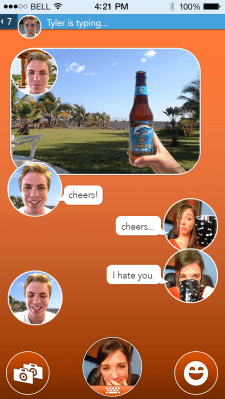Selfies aren’t done yet. Not by a long chalk. But neither are stickers — and in a battle between selfies and stickers which comes out on top?
The LA-based startup behind a new iOS messaging app, React Messenger, reckons it has come up with an addictive way to blend the two — turning selfies into sticker-esque emoticons that capture your real-time facial expression. It’s calling this a “selfie messenger” app.
The point, says the startup, is to inject more expression into text messaging. Instead of texting your friend on Viber, say, and sending a sticker of a cartoon pout, you can use React instead and add your very own pout to your missive. Or you can if you convince your friends to sign up.
React’s developers have been working on the app since October 2012. I tested it out ahead of its release on the App Store last night and soon found I was running out of silly faces to pull. But I’m definitely some way north React’s target demographic of selfie-obsessed teens.
The app follows in the freshly pressed footsteps of Bieber-backed selfie-sharing app Shots of Me, or the likes of Context, a messaging app that also lets you contextualise your typed missives with, you guessed it, a selfie.
React also has the distinct look of Facebook’s Chat Heads — being as its selfies are deliberately very small (to emphasise expression, it says) — except of course that every message you send via React is accompanied by a newly snapped selfie to capture your real-time expression. Happy, sad, frowny… er, happy, sad, frowny. And so on.
If you don’t want to sent any words at all you can just snap a selfie and send that. Or send a Frontback-esque twin snap showing what you’re looking at, and your face’s reaction to it (that’s known as a Reaction).
The result of all these selfies is a message thread that soon descends into am-dram. Or, as co-founder Pedro Alejandro Wunderlich tells it: “We’re bringing the ability to communicate what words can’t: sarcasm, love, jealousy, discomfort, etc, in real-time. We’ve created a messenger that allows you to communicate more emotional content, with less words.”
That’s *fewer* words Pedro, not “less”… [pedantic frown]
React’s creators have been self-funding development, using proceeds from a prior app they made — called Wake N Shake — which grabbed a lot of eyeballs by going down the AppGratis ‘make your app free’ for a weekend route, pulling in some 637,000 downloads in two days (this was before Apple pulled the plug on AppGratis’ scheme).
They’ve also been rushing to get React to market to surf the selfie wave. And before one of the current crop of messaging giants thinks of adding a ‘selfie snapping’ feature (although really you can already send photos on most messaging apps, ergo you can send selfies…).
But React argues their dedicated selfie-focused UI makes the process quicker & easier (with no need to peel away from your messaging to a separate camera function etc).
Asked how ‘selfie messaging’ is defensible, he says: “Being the first to market and hitting hard is our first line of defense. We stayed in the shadows as long as possible to launch a surprise attack! Also having (what we think is…) a cool name helps.”
It also apparently has a “provisional patent”. (Presumably around the interface mechanism, rather than, you know, attempting to claim ownership of sending photos of your face.)
Why does the world need more selfies? “From our beta test, we’ve noticed that conversations are funnier, more intense, and much more engaging — and you type less,” he says, adding: “Twenty beta testers have sent over 19,000 messages in the last 10 days. I think they like it.”
The app is of course free, with the monetisation question kicked into the long grass where the startup can squint at it later. It’s considering “subscriptions”, according to Pedro.
Messages sent via React are also “semi-ephemeral” — with the conversation feed holding only the 50 most recent messages. “After that, the new messages delete the old. There’s no history, no stored conversations,” he adds.
Considering the number of selfies already in digital circulation, that’s probably a good thing. In any case, even the most animated teen will probably have exhausted their selfie repertoire after 50 shots of themselves.
